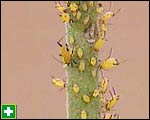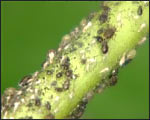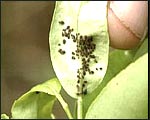Aphids
— the number one garden pest
They transmit diseases,
attack new buds and suck the sap from our plants. Aphids —
plant enemy number one.
 Aphids
must be the most pervasive garden insect pests of all. As soon as
any new growth appears in spring, aphids seem to materialise out
of nowhere. They come in all sorts of colours and attack a wide
range of plants. Aphids
must be the most pervasive garden insect pests of all. As soon as
any new growth appears in spring, aphids seem to materialise out
of nowhere. They come in all sorts of colours and attack a wide
range of plants.
These soft little critters
are real trouble-makers in the garden. While their damage is not
immediately obvious, they suck sap directly from the plant and,
because they always attack the newest growth, this sucking can damage
the most important growing parts.
What problems do aphids
cause for a plant?
- Sap is the plant´s
food source. When aphids suck sap from a plant, the plant becomes
weaker and weaker.
- Because aphids attack
the new buds, the resulting leaves and flowers never open properly
and they remain puckered and curled.
- Most damaging of all,
aphids can transmit serious virus diseases from one plant to another.
- During a particularly
bad aphid infestation, the sticky residue they leave behind on
the plant grows sooty mould, an unattractive fungal growth. Sooty
mould reduces the plant´s ability to photosynthesise.
Why are aphids so
successful?
 Aphids
look very vulnerable, but they have one major weapon that helps
them to be a winner in the survival stakes: they can multiply at
an incredibly rapid rate. Aphids
look very vulnerable, but they have one major weapon that helps
them to be a winner in the survival stakes: they can multiply at
an incredibly rapid rate.
As soon as the weather
warms up, aphids begin to reproduce rapidly. Their rate of increase
depends on temperature and it´s always highest in the moderately
warm spring period — they´re not particularly happy when
it´s very hot or very cold.
 Aphids
are great survivors. When conditions aren´t entirely to their
liking, adult aphids can lay eggs that will remain dormant, waiting
until better times arrive. When conditions are good, they´ll
bypass the egg-laying part of the process and give birth to live
young. They can develop seven or more generations in one year and
when the plant becomes too crowded, some members of the colony will
develop wings and fly away to search for a new food source. Aphids
are nearly all female, and they don´t even necessarily need
to have both sexes for reproduction. Aphids
are great survivors. When conditions aren´t entirely to their
liking, adult aphids can lay eggs that will remain dormant, waiting
until better times arrive. When conditions are good, they´ll
bypass the egg-laying part of the process and give birth to live
young. They can develop seven or more generations in one year and
when the plant becomes too crowded, some members of the colony will
develop wings and fly away to search for a new food source. Aphids
are nearly all female, and they don´t even necessarily need
to have both sexes for reproduction.
Ants protect and care
for aphids, just like miniature dairy farmers. They build shelters
for them, chase away predators and collect their eggs. In return,
the ants are able to feed off the aphids´ honeydew secretions.
How do you get rid
of aphids?
Squash and discourage
Aphids can simply be
squashed between your fingers (although it´s probably more
comfortable to wear rubber gloves!), hosed off or sprayed with a
soap and water mixture. Make sure you use soap, and not detergent.
Give succour to their
enemies
Encourage natural aphid
predators, such as birds, ladybirds and hoverflies. Yates Phacelia
has a pretty blue flower that attracts hoverflies into the garden.
Hit them where it
hurts
Use a contact insecticide
to directly shoot down aphid colonies. A low toxic synthetic pyrethroid
like Mavrik will give good aphid control.
Attack From Within
the Plant
Systemic insecticides
work from within the plant. Confidor is an effective, low toxic
and long-lasting suggestion.
Home-made insecticide
and fungacide
60ml liquid seaweed
fertiliser (or other liquid fertiliser)
1 tsp dishwashing detergent
2 Tbsp baking soda
1 litre water
Mix together all ingredients
and spray on infested plants once a week.
The liquid fertiliser
will nourish your plants, the dishwashing detergent helps the solution
to stick and also acts as an insecticide, and the baking soda will
change the leaf surface pH to alkaline. Fungal mould grows where
its host is acidic.

Reproduced
with permission from NZOOM Home and Garden content,
from the previous
website of 
The views expressed here are not necessarily those of the RNZIH
 |
|
HOME
AND GARDEN |
|
|
More
Garden Articles
|